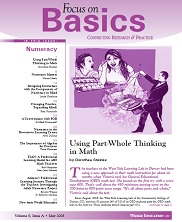Numeracy, more than prose and document literacy, is the skill most associated with employability, according to a national literacy survey as quoted by Myrna Manly, a numeracy expert based in California. Numeracy matters. It matters to individuals and to the nation. Manly artfully lays out the case for strengthening numeracy in adult basic education (ABE) in the article that begins on page 8.
Algebra matters: it's the gatekeeper into college. ABE students, regardless of their skill level, can and should start developing their algebraic thinking today. Tricia Donovan, Massachusetts, provides suggestions on how to do this in the article that starts on page 35.
Even the lowly equal sign matters. Many students think it signals only that "the answer is" rather than indicating the broader concept of equality. In our cover article, Dorothea Steinke, Colorado, describes how to change students' thinking about this sign, and about approaching math in general.
But what if your students are resistant to change? What if you're resistant to change? Kate Nonesuch, British Columbia, shares her techniques for introducing new types of activities into her math classroom (see page 20). She also gives us a peek at how she coaxes herself into trying these activities.
In the classroom, numeracy may seem limited to solving problems on a page, but using numeracy in real life requires the coming together of all sorts of cognitive and affective processes, explains Lynda Ginsburg, New Jersey (see page 14). What are these processes and how do we enable ABE students to develop them? Lynda examines many current math-teaching practices and suggests ways to alter them to ensure that students have more well-rounded skills in numeracy.
Teaching numeracy involves starting where students are, and moving on from there. If your students are mathematically in a place you've never been, you are faced with a challenge. Joanne Kantner, Illinois, reminds us that math is not exactly universal: different cultures think differently about mathematical concepts; they use different symbols and notation; and the contextual knowledge they bring to the classroom varies widely. Joanne talks with Focus on Basics about how she works with students from various cultures (see page 26).
To learn how to teach new approaches to numeracy involves first learning the approaches yourself, and also learning how to teach them. Researchers Mary Jane Schmitt, Massachusetts, and Beth Bingman, Tennessee, have been leading a research and development process called Teachers Investigating Adult Numeracy (TIAN), testing an intensive approach to professional development in six states. They share their model and what they have learned from TIAN in the article that begins on page 39. Beverly Wilson and Roberto Morales, of the Department of Education in Arizona, write about the decision to bring TIAN to Arizona, and how it was implemented across the state (see page 44).


